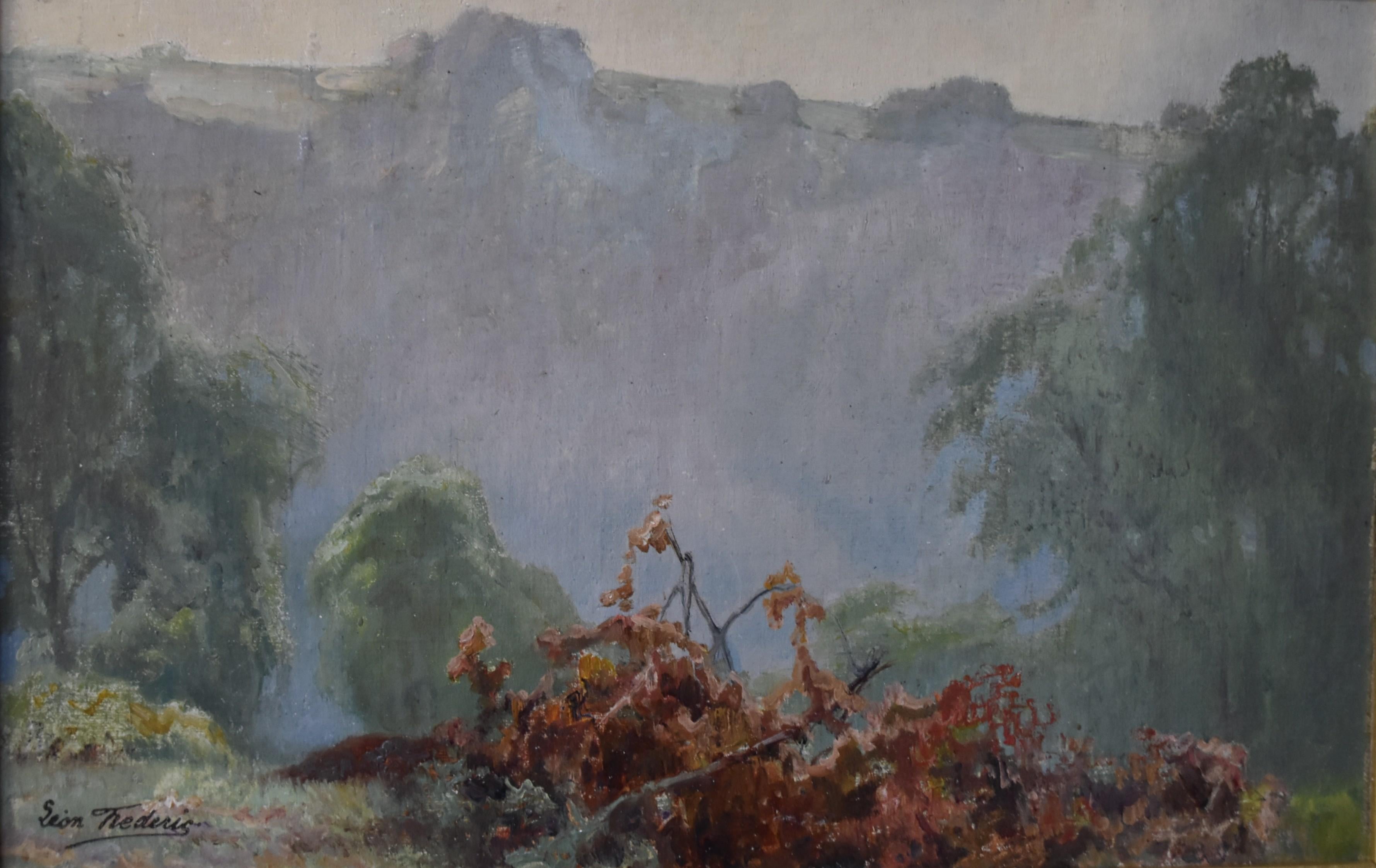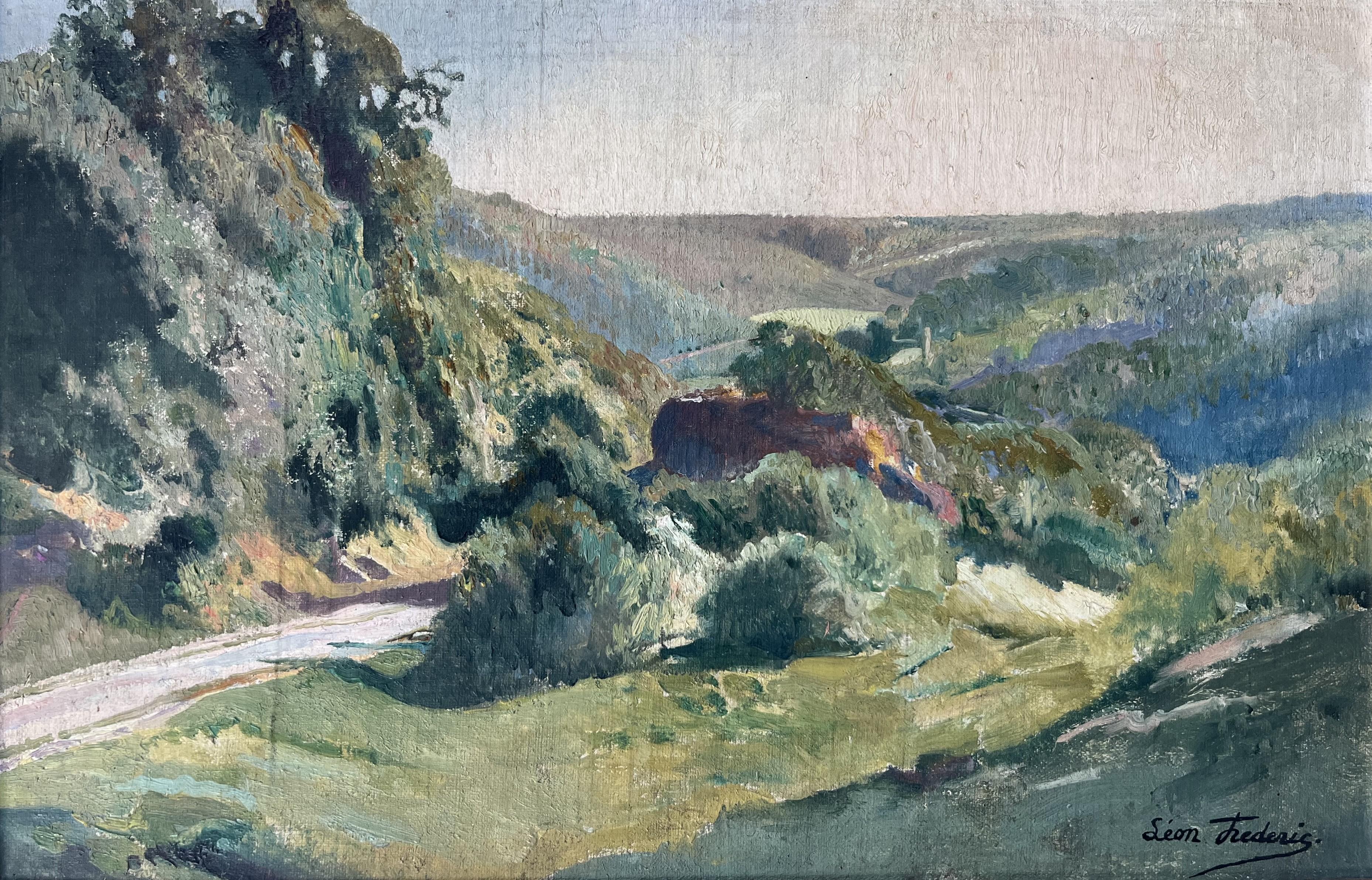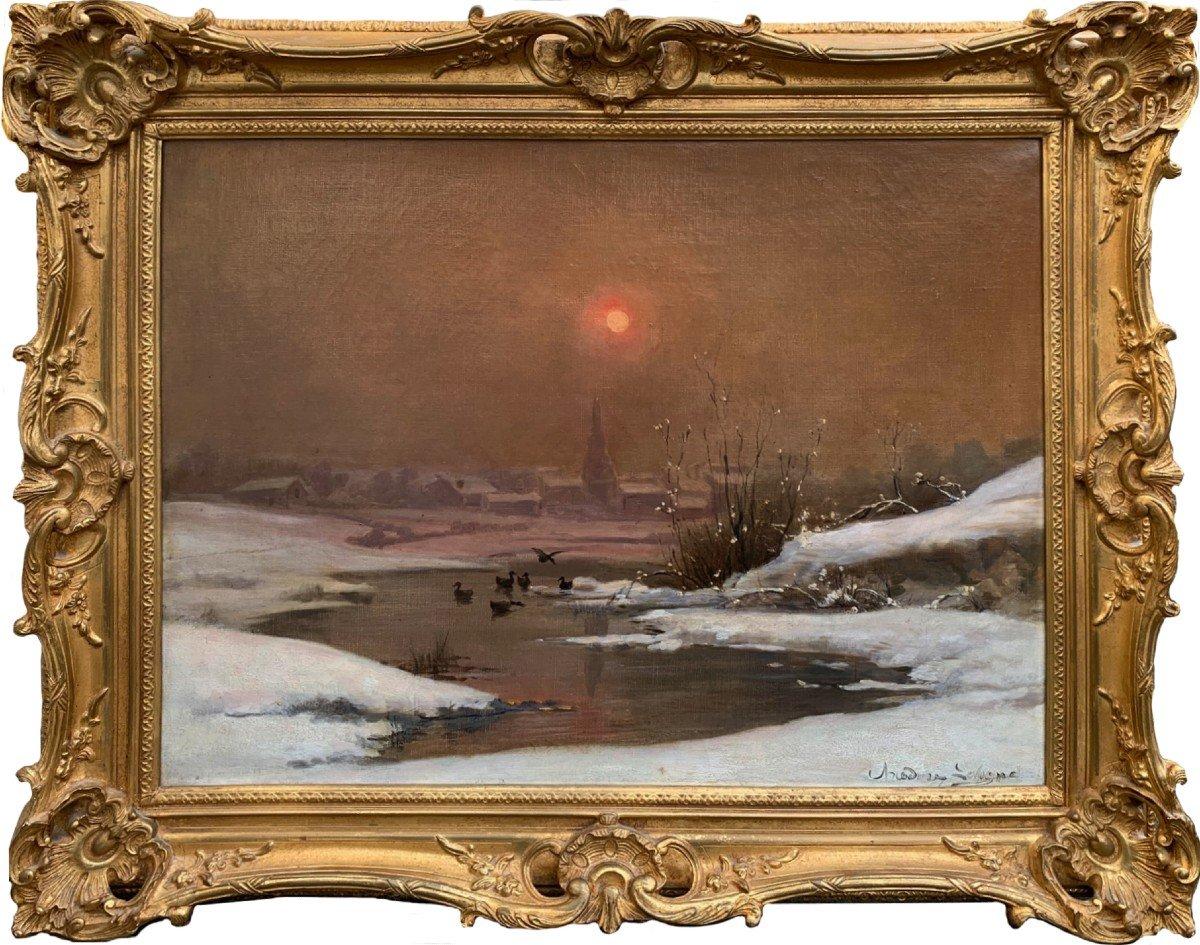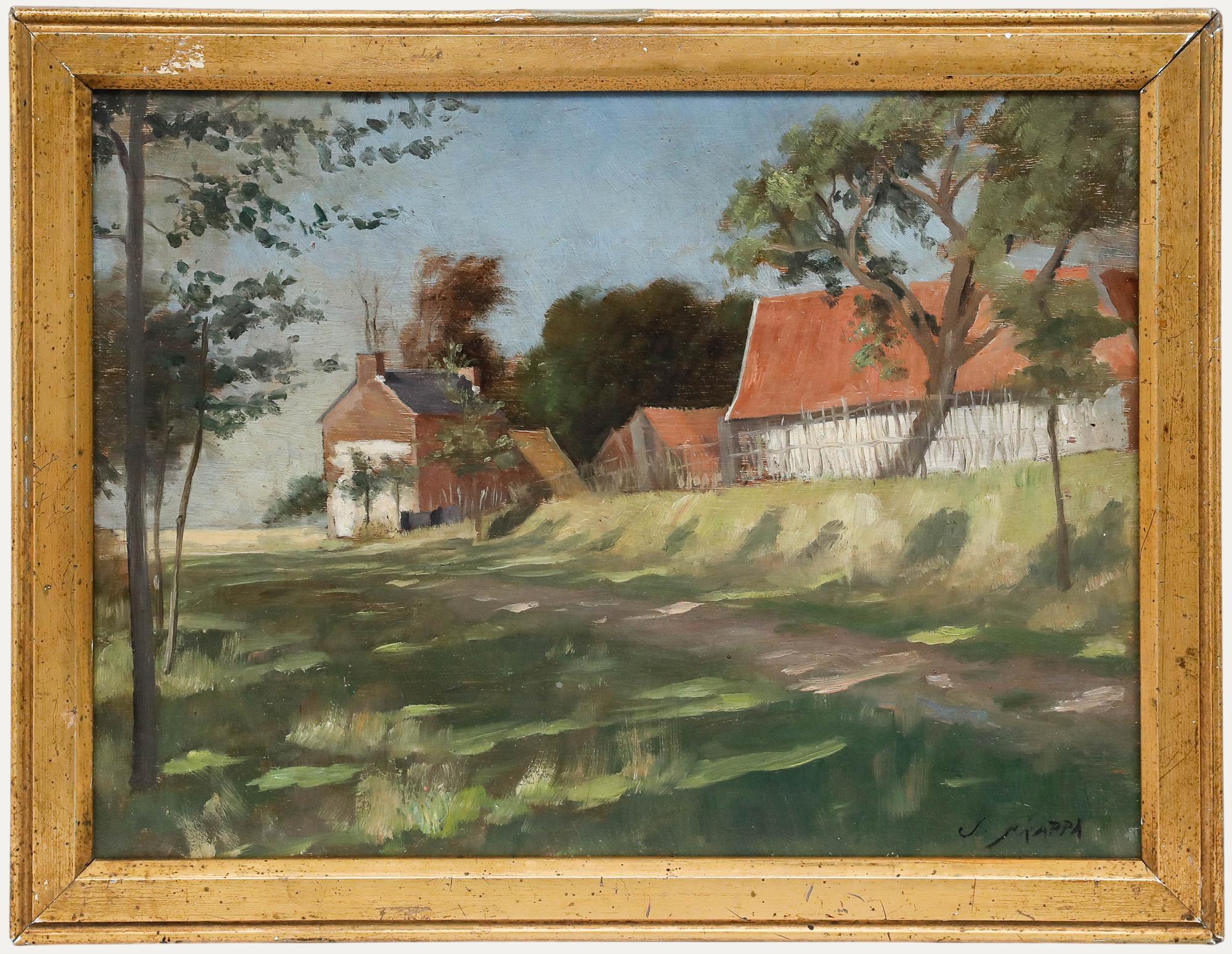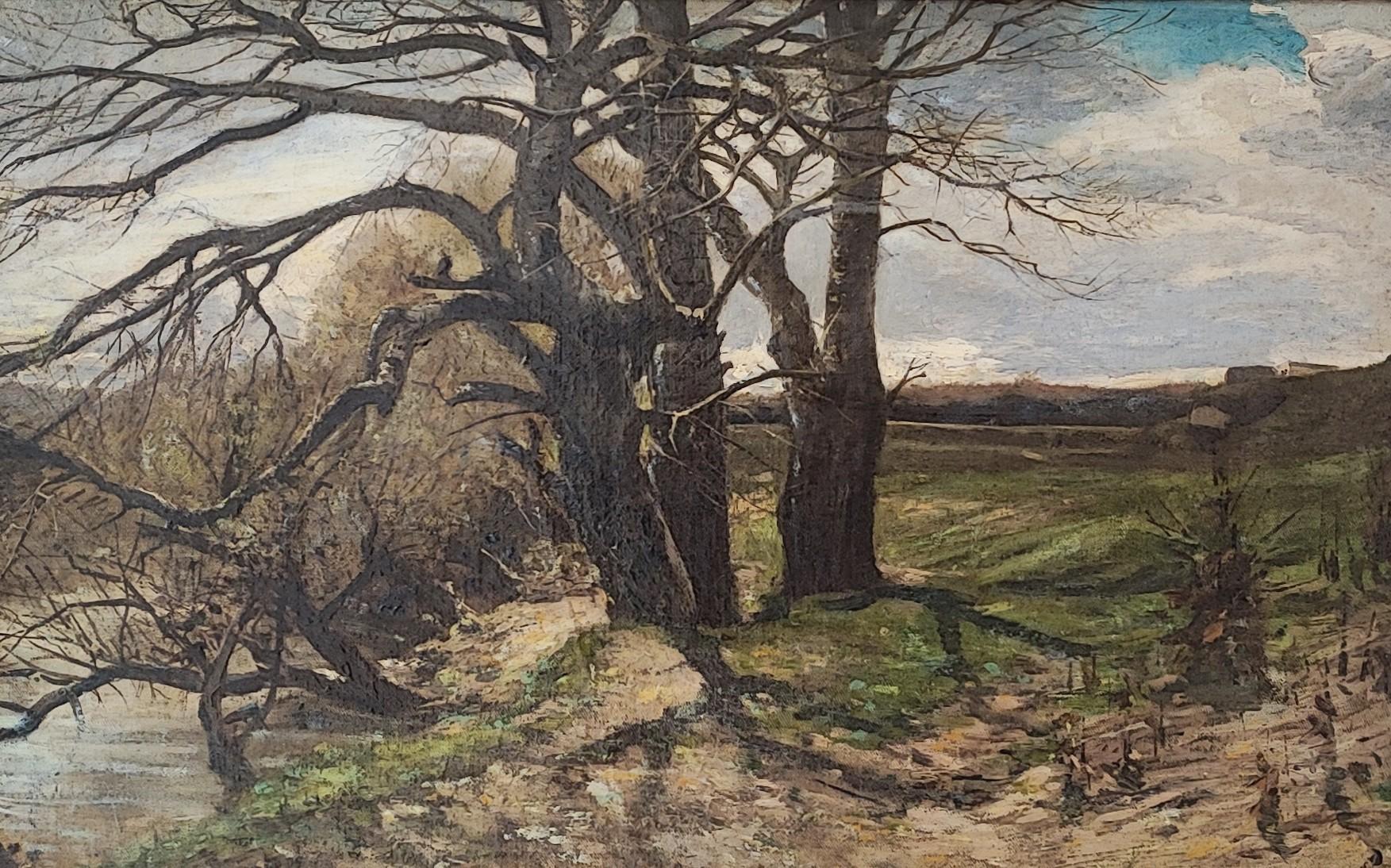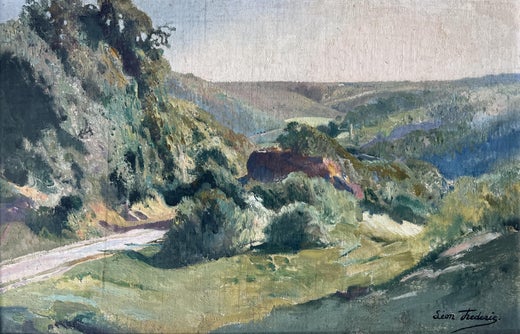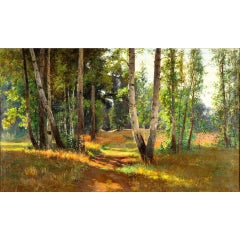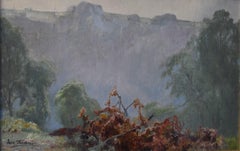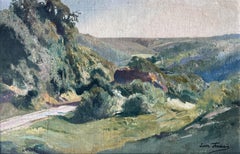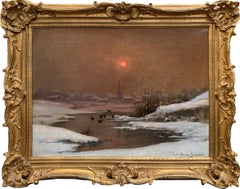Items Similar to Landscape at Nafraiture by Léon Frederic (1856 - 1940)
Want more images or videos?
Request additional images or videos from the seller
1 of 17
Léon FrédéricLandscape at Nafraiture by Léon Frederic (1856 - 1940)1883
1883
$5,904.91
£4,365.58
€4,950
CA$8,122.12
A$9,028.24
CHF 4,732.41
MX$110,256.61
NOK 59,081.39
SEK 55,584.56
DKK 37,684.27
About the Item
Léon Frédéric was one of the greatest representatives of Belgian symbolism and realism. He was ennobled as a baron in 1929 by King Albert I.
Discovered in 1883 by Léon Frederic on the occasion of the marriage of a cousin to the former village teacher, the village of Nafraiture and the Ardennes undoubtedly caught the attention of the painter. Every year, for forty years, the artist stayed with the farmers, staying with Philomène Poncelet, the village shopkeeper. His rural daily life inspires his main works exhibited in art fairs throughout Europe.
It will be possible to observe that this interest in the rural world, far from being isolated, is shared by a good number of artists on the European scene, from the famous Paul Gauguin to the more discreet Georges Lebrun. Léon Frederic's journey in the Ardennes proves to be as sincere as it is thoughtful, resembling a clear positioning of the artist in the artistic field.
Léon Frédéric: Landscaper, painter of allegories, religious and social subjects.
On August 26, 1856, Léon Frédéric was born in Ghent. He was the son of a master jeweler who introduced him very early to the art of drawing and painting. At fifteen, he was apprenticed to Charle-Albert, a renowned painter-decorator. The teenager is then entrusted to Jules Van Keirsbilck with whom Frédéric trains his eye and strengthens his hand. He attended evening classes at the Royal Academy of Fine Arts in Brussels for seven years. During this time, he frequented the workshop of Jean-François Portaels. In 1875, he joined forces with young painters to rent a studio where they could study live models.
From 1876 to 1878, he prepared for the Prix de Rome in which he failed the eliminatory test. Nevertheless, his father offers him enough money to travel to Italy for a whole year. He then made a long trip in the company of the sculptor Julien Dillens to Venice, Florence, Naples, Rome. He also visited England, Germany and the Netherlands. The travels oriented his career in a decisive way: the influence of the Italian primitives then combined with that of their English imitators, the Pre-Raphaelites, and of Edward Burne-Jones in particular. The same year, he exhibited for the first time at the Brussels Salon and made his debut within the group l'Essor which brought together proponents of realism. In 1882, Léon Frédéric discovered the inspiring work of the French naturalist painter Jules Bastien Lepage. His art is the bizarre alliance of a mannered naturalism and the naivety and luxuriance of the Quattrocento and the Flemish Primitives, often executed in the form of triptychs. Frédéric's paintings frequently take the form of esoteric allegories. It is the poetry of misery, of resignation, of silent duty, of courage. If the themes of his painting are sometimes those of the French realists, his manner differs considerably: unusual lighting, harsh and discordant colors, meticulous drawing where the modeling is accentuated to the point of unusualness, busy compositions contribute to the opposite, to “derealize” his painting. These works are enough to classify him as one of the masters of the Belgian symbolist movement. They also announce certain surrealist themes.
In 1883, he accompanied his cousin to the Ardennes, to Nafraiture. Inspired by the region, he settled there for more than twenty years and reached the peak of his art by mixing idealism with reality. He is hailed as a painter brimming with promise with his painting The Chalk Merchants, a triptych uniting modernism with the genius of the primitive Masters. At the Salon of 1877, Léon Frédéric exhibited his polyptych The Ages of the Peasant, which caused the general astonishment of critics and the public; its bold and revolutionary conception opens the door to a new trend in Belgian painting. In 1899, he moved to Schaerbeek and participated in numerous international fairs and exhibitions as well as Idealist Art fairs. This is in no way incompatible with his social concerns: on the contrary, Frédéric's work is entirely characteristic of this utopian symbolism whose unrealism is only a form of protest against the state of contemporary society and a call for a better future. This is how we must interpret his great allegories, with their revealing titles: The people, one day, will see the sun or The Ages of the Worker. What is affirmed in the various works of Léon Frédéric is the sympathy he feels for the unfortunate, the disinherited by fate, the needy fighting against poverty, doomed to an obscure, undeserved, and therefore unjust, destiny. But if the red flag flies in the second of these paintings, Frédéric often prefers to take refuge in the more reassuring theme of motherhood or consoling nature. Nature is omnipresent in the production of this artist, both in his landscapes and in his social works, where he realistically depicts the life of the peasants of Flanders or the workers of the Ardennes.
- Creator:Léon Frédéric (1856 - 1940)
- Creation Year:1883
- Dimensions:Height: 20.48 in (52 cm)Width: 27.96 in (71 cm)Depth: 2.37 in (6 cm)
- More Editions & Sizes:52 x 71Price: $5,905
- Medium:
- Period:
- Condition:
- Gallery Location:Gent, BE
- Reference Number:1stDibs: LU2140213699362
Léon Frédéric
Léon Frédéric was a Belgian Symbolist painter. In 1883, he moved to Nafraiture in the Belgian Ardennes. He painted the valley of Nafraiture several times, making it one of his principal themes of creation. In 1929, Frédéric created a Baron and Knight on the order of King Leopold. His works are present in several Museums, including Musée d'Orsay in Paris, Museums of Art and History in Brussels and at the Philadelphia Museum of Art.
About the Seller
5.0
Vetted Professional Seller
Every seller passes strict standards for authenticity and reliability
Established in 2018
1stDibs seller since 2022
5 sales on 1stDibs
Typical response time: 1 hour
- ShippingRetrieving quote...Shipping from: Gent, Belgium
- Return Policy
Authenticity Guarantee
In the unlikely event there’s an issue with an item’s authenticity, contact us within 1 year for a full refund. DetailsMoney-Back Guarantee
If your item is not as described, is damaged in transit, or does not arrive, contact us within 7 days for a full refund. Details24-Hour Cancellation
You have a 24-hour grace period in which to reconsider your purchase, with no questions asked.Vetted Professional Sellers
Our world-class sellers must adhere to strict standards for service and quality, maintaining the integrity of our listings.Price-Match Guarantee
If you find that a seller listed the same item for a lower price elsewhere, we’ll match it.Trusted Global Delivery
Our best-in-class carrier network provides specialized shipping options worldwide, including custom delivery.More From This Seller
View AllFrançois Théodore Isidore Verheyden (1880-1950) - Mont Saint-Victoire
Located in Gent, VOV
This painting by François Théodore Isidore Verheyden displays a vibrant and dynamic landscape, likely influenced by the Post-Impressionist movement. The foreground is dominated by tr...
Category
20th Century Landscape Paintings
Materials
Canvas
Paul-Édouard Crébassa (1864-1912) - River with water lillies
Located in Gent, VOV
Paul-Édouard Crébassa’s painting is a beautiful example of post-impressionist art, showcasing his ability to blend detailed observation with expressive techniques to capture the ephe...
Category
19th Century Landscape Paintings
Materials
Oil
View of Afsnee by Fritz Van Loo (1871-1957)
Located in Gent, VOV
Fritz Van Loo's "View of Afsnee" is a beautiful example of post-impressionist landscape painting, deeply influenced by the luminism of Emile Claus. The painting captures the serene b...
Category
20th Century Landscape Paintings
Materials
Oil
Vue d'un sous bois, tableau daté 1901, huile sur toile de Feodor Petrovich Rizni
Located in Gent, VOV
View of an undergrowth, 1901
Dimensions: 49 x 80 cm (unframed)
Oil on canvas
Signed lower left and dated
Fedor Petrovich Riznichenko - Russian and Ukrainian landscape painter, was ...
Category
20th Century Landscape Paintings
Materials
Canvas, Oil
Arsene Chabanian (1864-1949) the old watermill
Located in Gent, VOV
This fine pastel depicts a serene landscape featuring a flowing river, a bridge, and a building on the right side. The details in the painting, such as the texture of the foliage, th...
Category
20th Century Landscape Paintings
Materials
Pastel
On the banks of the Meuse near Waulsort by François Roffiaen (1820-1898)
Located in Gent, VOV
On the banks of the Meuse, near Waulsort (before the canalization of the Meuse)
Signed lower right
François Roffiaen (1820-1898): A Life in Brushstrokes
His kin, born from humble s...
Category
19th Century Landscape Paintings
Materials
Oil
You May Also Like
Léon Frédéric (1856-1940) Vallée de Nafraiture, Oil on panel
By Léon Frédéric
Located in Paris, FR
Léon Frédéric (1856-1940)
Vallée de Nafraiture
signed with the estate stamp at the lower left
Oil on canvas transfered on panel
29.5 x 44.55 cm
Certific...
Category
1930s Post-Impressionist Landscape Paintings
Materials
Oil
Léon Frédéric (1856-1940) A Summer landscape, Oil on panel signed
By Léon Frédéric
Located in Paris, FR
Léon Frédéric (1856-1940)
A Summer landscape
signed at the lower left
Oil on canvas transfered on panel
29 x 44 cm
Framed : 39 x 54.5 cm
in good condition, However, there is a cr...
Category
1930s Post-Impressionist Landscape Paintings
Materials
Oil
Paysage Enneigé De Théodore Levigne (1848/1912)
Located in GOUVIEUX, FR
Huile sur toile XIXe siècle Dim sans cadre 61/48 Dim avec cadre 75/61 Ecole française Signé Theodore Levigne en bas droite. Théodore Levigne est un peintre français, né le 17 novembr...
Category
Late 19th Century French School Landscape Paintings
Materials
Canvas, Oil
La moisson
Located in Atlanta, GA
Artist Ernest Chateignon was born in 1887. Ernest Chateignon exhibited at the Salon since 1867. Through his painting, he always marries peasant exis...
Category
19th Century Naturalistic Landscape Paintings
Materials
Oil
$28,080
Jose Frappa (1854-1904) - Framed Early 20th Century Oil, Farmhouse in France
Located in Corsham, GB
José Frappa (1854-1904) French impressionist, oil on wood panel. Signed 'J. Frappa' to the lower right. Presented in a distressed gilt effect frame. With stamped shield on panel verso.
Category
20th Century Landscape Paintings
Materials
Oil
Landscape
Located in Genève, GE
Work on canvas
Molded frame in wood and gilded plaster
64 x 84 x 7 cm
Category
Late 19th Century Italian School Landscape Paintings
Materials
Oil
More Ways To Browse
Italian Painting Peasants
Netherlands Painting Early 20th Century
Paintings Oil Edward Farmer
Red Baron
Bastien Lepage
Religious Triptych
Venice Flag
Julien Alberts
Primitive English Painting
Lepage Vintage
Leon Frederic
Triptych Console
Julien Dillens
1980 Boats
Apple Trees
Big Brother
Tom Browning Painting
Western Cowboy Painting
